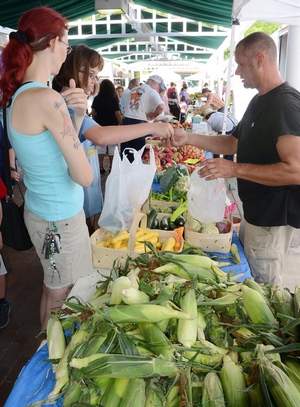Program aims to bring local produce into low-income homes
July 25, 2012
Source: Battle Creek Enquirer
Author: Jennifer Bowman
Randi Dale and her 15-year-old daughter walked away from the farmers market in Battle Creek on Wednesday with bags full of locally-grown corn, cantaloupe, peaches and cucumbers.
But instead of cash, the Battle Creek resident made her purchase with a different type of currency — tokens, provided by the Double Up Food Bucks (DUFB) program.
“It helps me in so many ways,” Dale said. “It allows my kids and my family to eat healthy.”

Randi Dale and her daughter, Cheyenne Ruddock, 15, of Battle Creek buy produce using Double Up Food Bucks from Rick Fuller of Countryside Produce at Battle Creek’s farmers market on Wednesday.
When customers use their Bridge Card to shop at participating farmers markets, they receive an equal amount of up to $20 of their purchase in DUFB tokens. The tokens can then be used to buy Michigan-grown produce at the market.
Much of the program, which runs from June to November, is funded by community foundations and state government agencies.
“Farmers markets are a great source of fresh and healthy locally-grown foods,” said Amanda Segar, food assistance partnership coordinator for Michigan Farmers Market Association. “Not all residents are able to access these foods unless they’re able to have financial assistance.”
Seventy-five farmers markets and three food trucks participated in the program this year — up from 54 markets and one food truck in 2011. It originally started two years ago at five markets in the Detroit area, said DUFB Program Director Rachel Chadderdon Bair, and has expanded into other areas of Michigan and in Ohio.
Local markets that participate in the program include those in Battle Creek, Bellevue, Springfield and at the Veterans Affairs Medical Center.
“We were one of the first markets that started with the program,” said Brigette Leach, secretary-treasurer of the Battle Creek Farmers Market Association. “We kind of tested the waters and saw a gradual pickup over the market season, and we saw an increase last year, certainly. This year it has just exploded.”
Rick Fuller, an employee of Countryside Produce, said sales have recently been boosted because of the DUFB program and other coupons.
“It’s 40 percent of our business, I’d say,” he said.
Nearly 2 million people in Michigan — about 20 percent of the state’s population — used the Supplemental Nutrition Assistance Program (SNAP) last year. Last year, the state led the Midwest in SNAP sales at farmers markets with more than $1 million. The second-highest state was Ohio with about $167,000, according to a 2011 DUFB evaluation report.
Bridge Card users made more than 40,000 visits to farmers markets to use the DUFB program last year and spent nearly $700,000 in SNAP benefits, according to the report.
“They’re really purchasing a balanced diet with these dollars,” Chadderdon Bair said, “and the economic benefit is spreading throughout the whole market.”
Segar said 104 of the 300 farmers markets in Michigan take Bridge Cards as a form of payment and at least 12 more are going through the process to accept them. Markets are encouraged to accept Bridge Cards for at least a year before participating in the DUFB program, she said.
But implementing the program has not been without its challenges.
“The first roadblock, always, is accepting Bridge Cards,” said Segar. “That process requires either paid staff time or volunteer time — it definitely requires an input of time.”
Leach said the program does create extra work for farmers markets in Battle Creek, which are run by a two-person management team and volunteers.
“Having the manpower to do the processing and appropriate recordkeeping are challenging for us,” she said. “That is our biggest hurdle.”
The program also requires the markets to have physical access to electricity or a phone line in order to accept Bridge Cards as a form of payment.
“Providing the resources both in terms of technological support and knowledge, as well as financial resources that actually meet the needs of every individual, is a very challenging thing to do,” Chadderdon Bair said.
Still, farmers seem pleased with the program. Seventy-five percent of surveyed vendors reported making more money and 80 percent reported selling more fruits and vegetables because of the DUFB program, according to its evaluation report.
“Some of (the vendors) will grumble a little bit,” Chadderdon Bair said, “but most of them recognize that it’s bringing new business into the market. Over the last two seasons, we’ve seen them be incredibly enthusiastic.”
Kelly Vallelunga of Long Valley Farms said she has seen the benefits of the program firsthand.
“I think it’s been wonderful,” she said. “It just makes it easier for a lot of people who can’t come to the market without help from the program.”
Originally posted at the Battle Creek Enquirer. Jennifer Bowman can be reached at jbowman@gannett.com.







